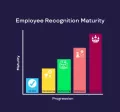
What Is Employee Recognition?
September 6, 2023
By Paul Ferguson
Every day, you do things that help the people around you. What you do day in and day out for your colleagues, your company and your clients makes a difference. The same is true for each and every one of your employees. Even the most self-motivated of us need to feel acknowledged and appreciated. It’s human nature. What does that mean in the workplace, though? What is employee recognition?
In short, employee recognition is a powerful tool to inspire and motivate your team. It shapes the employee experience and company culture. Done right, it can impact everything in a company, from productivity to profitability. According to research from Deloitte, employee engagement can increase productivity and performance by 14 percent.
Here’s what you need to know about employee recognition if you plan to build a program that drives results.
Why Employee Recognition Is Important In the Workplace
There are 168 hours in a week. The average full-time employee works 40 of those hours. While the numbers show that we don’t spend all our time at work, sometimes, it can absolutely feel that way.
A thoughtful, genuine employee recognition program has the potential to transform a workplace from a mere place of employment to an environment that meets the emotional needs of those who work there, uplifting and inspiring them to achieve greatness.
And that, in turn, has a reverberating positive impact on all aspects of the workplace – including the company’s bottom line. For example, Gallup's employee engagement research found that highly engaged teams increased 23 percent profitability. The importance of employee recognition in the workplace cannot be overstated.
Benefits of Implementing Employee Recognition Programs
Employee recognition programs are a strategic investment that pays dividends, both for individuals and for the company as a whole.
The benefits are wide-ranging:
- Job Satisfaction: Recognition makes employees feel valued and appreciated for their efforts, leading to higher job satisfaction and overall happiness at work.
- Employee Motivation: Showing appreciation can make employees feel more motivated to excel in their roles, driven by the knowledge that their contributions are recognized and valued.
- Employee Engagement: Employees who feel valued and appreciated tend to be more engaged with their work, leading to improved productivity and performance.
- Employee Well-Being: Feeling valued and recognized positively impacts employees' mental and emotional well-being, reducing stress and burnout.
- Alignment with Organizational Values: Recognition programs can be used as a tool to reinforce the behaviors and attitudes that drive success, leading to better alignment between the workforce and the organization's core values.
- Innovation and Creativity: Recognized employees feel empowered to think outside the box, leading to increased innovation and fresh ideas.
It really is a win-win for both the employer and the employee. Getting the most out of your recognition program doesn’t have to be hard.
Employee Recognition Strategies
Knowing the benefits of a recognition program and actually putting it into action are two very different things.
That’s where the different types of employee recognition strategies make a difference. Being strategic about how and when to reward employees for their contributions drives more impact compared to an ad hoc approach.
No matter what kind of recognition program you are building, keep these key strategies in mind:
- Timely Acknowledgment: Recognize achievements and efforts promptly to reinforce positive behavior.
- Personalization: Tailor recognition and rewards to each employee’s personal preferences, showing that their individuality is valued.
- Regular Feedback: Create a culture of ongoing feedback, where managers and peers provide constructive input and praise regularly for both big and small achievements.
- Peer-to-Peer Recognition: Encourage employees to acknowledge and celebrate each other's achievements, fostering a sense of camaraderie and teamwork.
- Transparent Criteria: Clearly communicate the criteria for recognition to ensure fairness and transparency in the process.
- Tangible Rewards: Combine recognition statements with rewards such as gifts or points-based shopping to thank employees in more tangible ways.
These strategies underpin the foundation of effective employee recognition programs.
Examples of Employee Recognition Initiatives
Employee recognition initiatives come in various forms – what works for one organization may not be the best fit for another.
But if you are wondering where to start, these examples of employee recognition initiatives can provide some inspiration.
- Employee of the Month or Peer Nominations awards that recognize outstanding employees on a periodic basis.
- Spot awards to highlight achievements on a daily basis, such as a shout-out during standing team meetings.
- Personalized thank you cards or digital messages.
- Team celebrations or events, especially for milestone moments or significant achievements.
- Points-based incentive programs for physical gifts, company-branded products, gift cards, or other tangible rewards. An employee engagement platform like Connects Plus makes it easy to offer points-based reward shopping.
The most effective programs should include both simple, daily recognition elements and more complex, programmatic components for maximum impact.
How Employee Recognition Correlates to Employee Retention
There is a direct correlation between employee recognition and employee retention. When employees feel valued and recognized, they are more likely to stay committed to the organization.
In fact, over and over research shows the importance of employee recognition and its role in employee retention. According to Harvard Business Review, one of the top reasons employees leave – or consider leaving – their place of employment is because they don’t feel valued. The other main reason? Because they lack a sense of belonging.
An employee recognition program addresses both of these issues.
Fostering Company Culture Through Employee Recognition
Creating a positive, supportive workplace environment that recognizes each individual’s contributions goes a long way in keeping employees motivated and happy. In this day and age, organizations need to use employee recognition as a tool for fostering company culture in order to remain competitive.
It’s simply one of the most powerful ways to shape company culture.
When recognition is ingrained in an organization's DNA, it becomes a part of everyday culture. And that’s a culture that attracts and retains top talent, inspires great work, and holistically supports employees.
Want to learn how to create and implement an Employee Recognition Program for Your Organization? Speak with a Specialist today!




